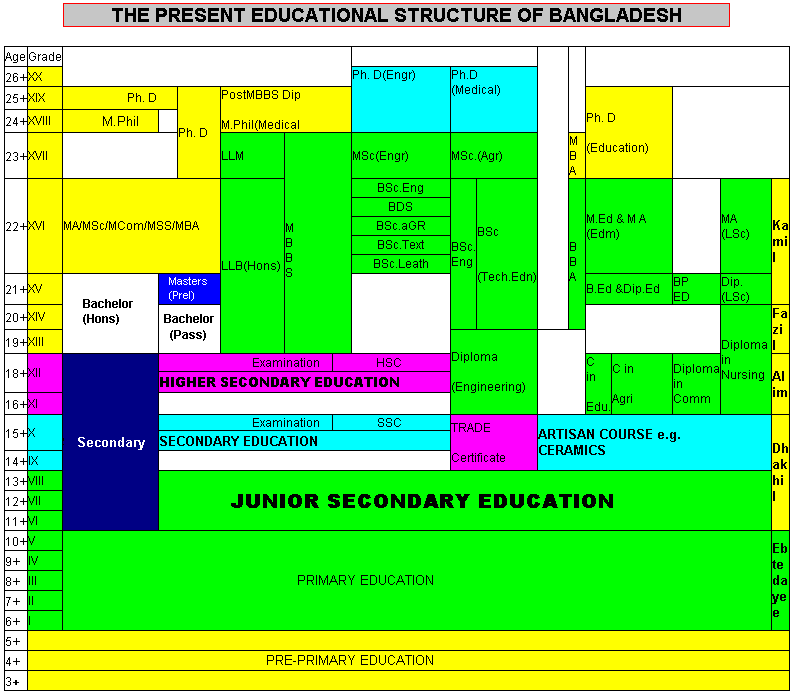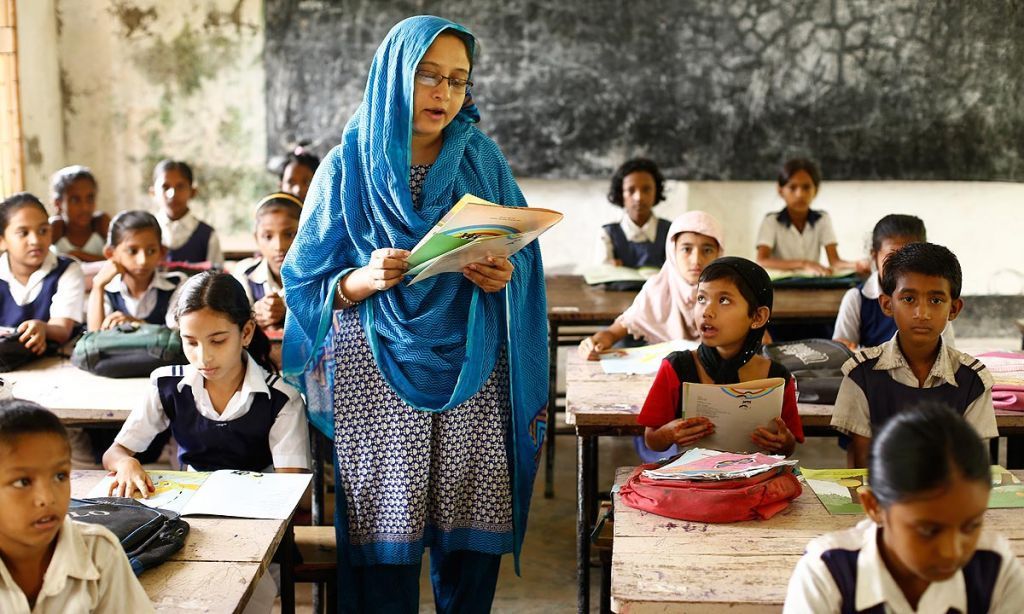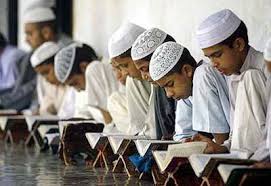The Education System of Bangladesh
From Wikipedia
"The educational system in Bangladesh is three-tiered and highly subsidised. The government of Bangladesh operates many schools in the primary, secondary, and higher secondary levels. It also subsidises parts of the funding for many private schools. In the tertiary education sector, the government also funds more than 15 state universities through the University Grants Commission.''
Education System
The main education system is divided into three levels:
1.Primary Level (Class 1–8)
2.Secondary Level (Class 9–12)
3.Tertiary Level

At all levels of schooling, students can choose to receive their education in English or Bangla. Private schools tend to make use of English-based study media while government-sponsored schools use Bangla.
Cadet Colleges are important in the education system of Bangladesh. A cadet college is a room and board collegiate administered by the Bangladesh. Military discipline is compulsory at all cadet colleges. Faujdarhat Cadet College is the first cadet college in Bangladesh, established in 1958 over an area of 185 acres (0.75 km2) at Faujdarhat in the district of Chittagong. At present there are 12 cadet colleges in Bangladesh, including 3 cadet colleges for girls.
Picture:Mirzapur Cadet College Students
Primary education
The overall responsibility of management of primary education lies with the Ministry of Primary and Mass Education (MOPME), set up as a Ministry in 1992. While MOPME is involved in formulation of policies, the responsibility of implementation rests with the Directorate of Primary Education (DPE) headed by a Director General. The Directorate of Primary Education (DPE) and its subordinate offices in the district and upazila are solely responsible for management and supervision of primary education. Their responsibilities include recruitment, posting, and transfer of teachers and other staff; arranging in-service training of teachers; distribution of free textbooks; and supervision of schools. The responsibility of school construction, repair and supply of school furniture lies with the DPE executed through the Local Government Engineering Department (LGED). The National Curriculum and Textbook Board (NCTB) is responsible for the development of curriculum and production of textbooks. While the Ministry of Education (MOE) is responsible for formulation of policies, the Directorate of Secondary and Higher Education (DSHE) under the Ministry of Education is responsible for implementing the same at secondary and higher education levels. The NCTB is responsible for developing curriculum and publishing standard textbooks.
Picture:A teacher is teaching in Primary School Students.
The Directorate of Primary Education (DPE) are responsible for conducting the two public examinations:
Primary School Certificate (PSC) (5th grade)
Junior School Certificate (JSC) (8th grade)
Secondary education
The secondary level of education is controlled by the eight General Education boards:
Barisal Education Board for Barisal Division
Chittagong Education Board for Chittagong Division
Comilla Education Board for Comilla Division
Dhaka Education Board for Dhaka Division and Mymensingh Division
Dinajpur Education Board for Rangpur Division
Jessore Education Board for Khulna Division
Rajshahi Education Board for Rajshahi Division
Sylhet Education Board for Sylhet Division
The boards' headquarters are located in Barishal, Comilla Chittagong, Dhaka, Dinajpur Jessore, Rajshahi and Sylhet.
Eight region-based Boards of Intermediate and Secondary Education (BISE) are responsible for conducting the two public examinations:
Secondary School Certificate (SSC) (10th grade)
Higher Secondary School Certificate (HSC) (12th grade)
At the school level, in the case of non-government secondary schools, School Management Committees (SMC), and at the intermediate college level, in the case of non-government colleges, Governing Bodies (GB), formed as per government directives, are responsible for mobilising resources, approving budgets, controlling expenditures, and appointing and disciplining staff. While teachers of non-government secondary schools are recruited by concerned SMCs observing relevant government rules, teachers of government secondary schools are recruited centrally by the DSHE through a competitive examination.
In government secondary schools, there is not an SMC. The headmaster is solely responsible for running the school and is supervised by the deputy director of the respective zone. Parent Teachers Associations (PTAs), however, exist to ensure a better teaching and learning environment.

Picture:In secondery level school.
Tertiary education
Entrance of, Islamic University of Technology(IUT)
Civil Engineering department of BUET. BUET is regarded as one of the best universities for engineering education in Bangladesh
At the tertiary level, universities are regulated by the University Grants Commission.The colleges providing tertiary education are under the National University. Each of the medical colleges is affiliated with a public university. Universities in Bangladesh are autonomous bodies administered by statutory bodies such as Syndicate, Senate, Academic Council, etc. in accordance with provisions laid down in their respective acts.
English language schools
A vast number of schools in Bangladesh are English version schools. English Medium schools are mainly private schools where all the courses are taught in English except one Bengali Language subject at ordinary level (O Level). These schools in Bangladesh follow the General Certificate of Education (GCE) syllabus where students are prepared for taking their Ordinary Level (O Level) and Advanced Level (A Level) examinations. The General Certificate of Education system is one of the most internationally recognised qualifications, based in the United Kingdom. The Ordinary and Advanced Level examinations are English equivalent to the Secondary School Certificate (SSC) and Higher Secondary School Certificate (HSC) examinations respectively. Most students sit for these exams from the registered schools in Bangladesh who follow the GCE syllabus. Those who do not attend a school that follows the GCE syllabus may also sit for their Ordinary and Advanced Level examinations from the British Council. These examinations are conducted under the supervision of the British Council in Bangladesh. The GCE examination conducted by the British Council takes place twice a year. Currently there are two boards operating from Bangladesh for Ordinary and Advanced Level Examinations, which are Edexcel and University of Cambridge International Examinations. Bangladesh has recently opened English Version education translating board textbooks in English.
Madrasah education[edit]
The Madrasah Education System focuses on religious education, teaching all the basics of education in a religious environment. Religious studies are taught in Arabic and the students in some areas also serve the local area masjids. Students also have to complete all the courses from the General Education System. Many privately licensed Madrasas take in homeless children and provide them with food, shelter and education, e.g. Jamia Tawakkulia Renga Madrasah in Sylhet. In the Madrasah Education System there are two systems:
One, called the "Quomi" Madrasah system is privately owned and funded and is run according to the Deobandi system of Islamic education, which rejects the rational sciences.
The other, called the "Alia" madrasah system, is privately owned but subsidised by the government (the government spends 11.5% of its education budget on alia madrasahs, paying 80% of teacher and administrator salaries). Quomi madrasahs account for 1.9% of total primary enrollment and 2.2% of secondary enrollment; aliyah madrasahs account for 8.4% of primary and 19% of secondary enrollment. The alia system is like the general education system, except that Arabic is taught in addition to general education. The Madrasah Education Board covers religious education in government-registered Madrasahs in the secondary level. After passing "Alim", a student can enroll for 3 additional years to obtain a "Fazil" level. Students can go for further general education and earn a university degree. After passing successfully, they can further enroll for another 2 years to obtain a "Kamil" level degree.[citation needed]
Picture:Madrashah Students of Bangladesh .
Current Issues
Current government projects to promote the education of children in Bangladesh include compulsory primary education for all, free education for girls up to grade 10,[citation needed] stipends for female students, a nationwide integrated education system and a food-for-education literacy movement. A large section of the country's national budget is set aside to help put these programs into action and to promote education and make it more accessible. Recent years have seen these efforts pay off and the Bangladesh education system is strides ahead of what it was only a few years ago. Now even national curriculum books from class 5 to class 12 are distributed freely among all students and schools. Bangladesh is now trying to establish remote and digital classes through internet conferences.
The educational system of Bangladesh faces several problems. In the past, Bangladesh education was primarily a British modelled upper class affair with all courses given in English and very little being done for the common people. The Bangladesh education board has taken steps to leave such practices in the past and is looking forward to education as a way to provide a poverty-stricken nation with a brighter future. As Bangladesh is an overpopulated country, there is a huge demand to turn its population into labour, which is why proper education is needed and proper help in the educational sectors of Bangladesh from the government are crucial.Besides of all these problems,Bangladesh is developing fast in education.A high number of female students is taking education.The male female ratio is about 50:50
Education expenditure as percentage of GDP
Public expenditure on education lies on the fringes of 2 percent of GDP with a minimum of 0.94 percent in 1980 and a maximum of 2.2 percent in 2007.
Qualitative dimension
The Education system lacks a sound Human Resource Development and deployment system and this has demoralised the primary education sector personnel, including teachers, and contributes to poor performance. Poverty is a big threat to primary education. In Bangladesh, the population is very high. The number of seats available in colleges is less than the number of students who want to enroll, and the number of seats available in universities is also less than the number of students who passed higher secondary level and want to join in a university. Besides, the cost of education is increasing day by day, as a result many students are unable to afford it.
One study found a 15.5% primary school teacher absence rate.
Gender disparity
In Bangladesh, gender discrimination in education occurs amongst the rural households but is non-existent amongst rich households.There is great difference in the success rates of boys, as compared to girls in Bangladesh. However, in recent years some progress has been made in trying to fix this problem.
School attendance
The low performance in primary education is also matter of concern. School drop-out rates and grade repetition rates are high. Poor school attendance and low contact time in school are factors contributing to low level of learning achievement.
Religion and education
Education in Bangladesh is heavily influenced by religion.
Literacy rate
Bangladesh has one of the lowest literacy rates in Asia, estimated at 66.5% for males and 63.1% for females in 2014. Recently the literacy rate of Bangladesh has improved as it stands at 71% as of 2015 due to the modernization of schools and education funds.
Conclution
As a poor country,Bangladesh has to fight against many things.About 250 years ago,Bangladesh was one of the richest area in the world.Then Bangla provide many brilliants.But after British and Pakistan period,the system broke.She is trying her best to make her children best.
N.B. Some information was taken from wikipedia.Picture was taken from varios websites.


.jpg)
Hi! I am a robot. I just upvoted you! I found similar content that readers might be interested in:
https://en.wikipedia.org/wiki/Education_in_bangladesh
Hello Friends, How Are You
Thank You Friend nice To Meet You @diamondfx
the Best And amazing.
My Name @kouba01 I Am Coming From Tunisia
I Say Welcome And Happy To You Here #steemit or#eSteem.
Do not Forget Follow Me Also @kouba01
I would like to express my gratitude
This post has received a 0.39 % upvote from @drotto thanks to: @banjo.
Congratulations! This post has been upvoted from the communal account, @minnowsupport, by mrrifat1 from the Minnow Support Project. It's a witness project run by aggroed, ausbitbank, teamsteem, theprophet0, and someguy123. The goal is to help Steemit grow by supporting Minnows and creating a social network. Please find us in the Peace, Abundance, and Liberty Network (PALnet) Discord Channel. It's a completely public and open space to all members of the Steemit community who voluntarily choose to be there.
If you like what we're doing please upvote this comment so we can continue to build the community account that's supporting all members.
upvoted @jero1